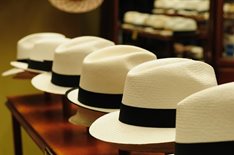
Rhett Butler wears one as he rescues Scarlett and Melanie from the Yankee invasion of Atlanta in
Gone with the Wind. Victor Lazlo impressively turns up in
Casablanca with a pristine one, despite having just escaped from a Nazi prison camp. Charles Ryder and Sebastian Flyte wear them throughout their Byronic visit to Venice in
Brideshead Revisited, and you can bet Lord Grantham wouldn’t be caught dead on the Downton Abbey cricket pitch without one. Panama hats have been a staple of the aristocratic wardrobe on both sides of the Atlantic for more than a century, earning their popularity not only for their sartorial cachet but also for the durability and functionality of the tightly-woven strands of palm leaves, which provide optional protection from the sun.
However, the name “Panama” is a deliberate misnomer and clever marketing for a hat that originated and continues to be hand-woven in Ecuador rather than its more popular neighbor. The dried and bleached leaves of the
Carludovica palmata plant, native to Ecuador, have been used to craft superior, durable, and lightweight straw hats since the mid-nineteenth century.
But Ecuador was a bit of a backwater lacking a significant domestic or international market for their sun hats, and so canny traders found eager buyers in neighboring Panama, which even before the construction of its eponymous canal enjoyed brisk trans-continental traffic from pioneers, the gold rush, and the American military. Until the advent of mainstream civilian aviation after World War II, Panama was the quickest way to travel from coast to coast in the western hemisphere and the region teamed with fair-faced foreigners, all needing protection from the harsh tropical sun. Word spread of the effectiveness tightly-woven hats the savvy Ecuadorians sold in Panama and soon celebrities such as Theodore Roosevelt were spotted wearing the signature white hats with black ribbons.
The finest Panama hats continue to be woven in Ecuador where master weavers are instantly recognizable by their long thumbnails, with which they split the leaves into the incredibly thin strips to fashion the iconic hats. The best hats continue to come from the villages of Montecristi in the west and Cuenca in the Andes Mountains. These regions produce hats where the weave can be as thin as an astonishing (and very expensive) 33 rows from the brim to the middle of the hat. But, according to the
Financial Times’s authoritative
How To Spend It column, Panama hats with more than 18 hand-woven rows are perfectly acceptable for that must-have accessory for warm-weather social and sporting events such as polo matches, the boat races at Henley-on-Thames, the cricket at Lord’s, or the lawn tennis championships at Wimbledon.
Alexander+Roberts handcraft fascinating itineraries throughout South America such as
The Complete Panama Canal, which includes a memorable complete sea transit through the legendary Canal.